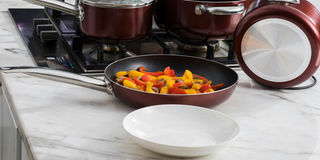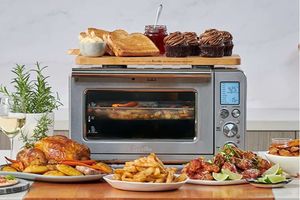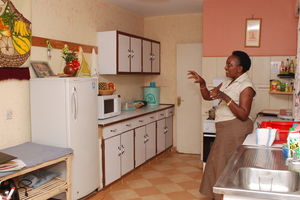
Use heat-resistant paint to prevent issues such as peeling or bubbling. PHOTO/UNSPLASH.COM.
Painting kitchen appliances offers homeowners a flexible and cost-effective way to refresh their kitchen’s look. Instead of investing in new appliances, which can be expensive, many are turning to this DIY solution to achieve a personalised and updated home design. But before you dive into painting your appliances, it is essential to understand whether this method is safe and what key factors to consider.
Choosing paint
Eve Mbabazi, an interior designer based in Entebbe, emphasizes the importance of selecting paints specifically designed for metal surfaces and thoroughly preparing appliances before painting. According to Mbabazi, using a primer suited for metal is crucial for achieving a smooth and durable finish.
“Choose paints that are explicitly labeled as non-toxic and safe for surfaces that come into contact with food,” she advises. “void paints containing harmful chemicals like lead or cadmium. Proper ventilation during the painting and curing process is also essential to minimise indoor air pollution.” She recommends selecting paints with certifications or labels indicating low volatile organic compounds (VOCs) and the absence of harmful chemicals, as these are generally safer.
For appliances exposed to high temperatures, such as ovens, kettles, stoves, and toasters, many paints may not be suitable due to their inability to withstand extreme heat. This can result in discoloration or deterioration of the finish.
When painting such appliances, it is important to use heat-resistant paint to prevent issues such as peeling or bubbling. On the other hand, standard appliance paint is generally adequate for refrigerators, dishwashers, and other non-heat-producing appliances.
Imelda Nambubi, a homeowner, highlights the versatility of painting kitchen appliances as a method to update spaces in line with current trends and personal preferences while maintaining functionality.
“After extensive research online and consultations with a local hardware store, I decided to paint my refrigerator to complement my newly renovated kitchen,” Nambubi explains. “I selected a high-quality enamel paint specifically recommended for metal surfaces. Two years later, the finish remains pristine and unblemished.”
Joyce Onapa, a homeowner in Bulindo, says she chose to paint her old rice cooker to match her kitchen décor and was impressed by the results.
“It not only enhanced the look of my kitchen but also saved me money. I made sure to follow expert advice and used paint that was safe for surfaces in contact with food. More than year later, the finish still looks excellent,” she says.
Aesthetic enhancement
Ahmed Kabuulwah, a painter, notes that appliances can appear outdated over time, even if they remain in good working condition.
“Painting them can refresh their appearance and help them better align with contemporary kitchen designs. Whether you prefer a sleek, modern look with stainless steel or bold, vibrant colours, painting offers a high degree of flexibility,» he explains.
He also recommends that for a cohesive design, using a mix of different appliance brands or styles and painting them the same colour can create a more unified and harmonious look in the kitchen.

A new coat of paint means protecting the appliance’s surface from further wear and tear.
Cost-effective solution
For homeowners, painting is a more affordable option. It allows one to achieve a fresh look without a significant financial investment thus giving you a sense of achievement and pride in your living space.
“Painting can breathe new life into older appliances, making them look new again and delaying the need for replacement,” Nambubi notes adding that applying a new coat of paint means protecting the appliance’s surface from further wear and tear, scratches, and rust, improving the durability and longevity of the appliance.
For an effective painting process Kabuulwah says certain steps should be followed:
Preparation
Cleaning: Thoroughly clean the appliance with a degreaser or soapy water to remove any grease, dirt, and residues. This step ensures the paint adheres properly.
Sanding: Lightly sand the surface with fine-grit sandpaper to create a slightly rough texture for the paint to grip. Wipe off the dust with a damp cloth after sanding.
Masking: Use painter’s tape to cover areas you do not want to paint, such as handles, buttons, vents, and logos. Remove any detachable parts if possible, like handles and knobs, to make painting easier.
Application
Primer: Apply a primer designed for metal surfaces if the appliance is not pre-primed. This helps with paint adhesion and durability.
Painting: Shake the paint can well if using spray paint. Hold the can about eight to 12 inches away from the surface and spray in a sweeping motion. Apply several thin, even coats rather than one thick coat to avoid drips and ensure a smooth finish.
Drying between coats: Allow each coat to dry thoroughly as per the manufacturer’s instructions before applying the next one. This usually takes about 15-30 minutes, but check the paint can for specific drying times.
Curing time: For the paint to fully cure and reach maximum hardness, it may take several days. Follow the manufacturer’s curing instructions, which often recommend avoiding heavy use or cleaning of the appliance during this period.
Kabuulwah notes that even with careful application, achieving a perfectly uniform finish can be challenging, leading to visible brush strokes or uneven coloration.
He tips that use of a high-quality brush or spray gun for application to minimise brush strokes can help achieve a more even finish. Applying multiple thin coats rather than one thick coat can also help attain a smoother appearance.
Maintenance
Kabuulwah, notes that a freshly painted surface can be easier to clean and maintain. Some specialty paints provide additional benefits like anti-fingerprint or easy-clean finishes, which can be particularly useful in a kitchen environment.
“While painting, apply multiple thin coats of paint for an even finish, allowing each coat to dry completely before proceeding. Understand that painted surfaces may require occasional touch-ups or maintenance to uphold their appearance,” Kabuulwah adds.
Regular use and cleaning make painted surfaces on appliances prone to chipping, peeling, or scratching over time. To enhance durability, use high-quality, appliance-specific paint that is designed to withstand frequent use and cleaning. Additionally, avoid abrasive cleaning tools and harsh chemicals that can damage the painted surface.
Safety precautions
Keep children and pets away from the painting area to prevent inhalation of fumes and accidental contact with wet paint.
Storage of materials: Store paints, solvents, and cleaning agents in a cool, dry place, away from open flames, heat sources, and out of reach of children and pets.
Disposal: Dispose of used paint cans, rags, and other materials responsibly according to local regulations.




